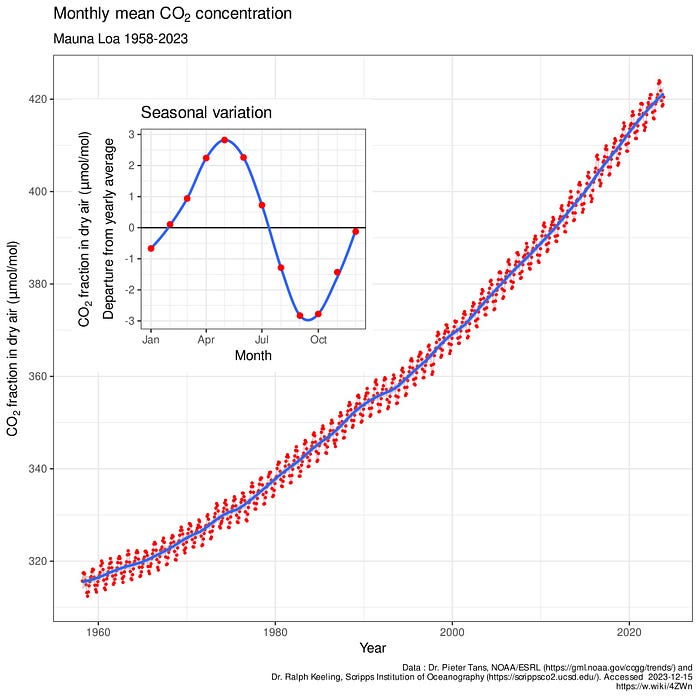Pictured is the history of atmospheric carbon dioxide concentrations measured at the Mauna Loa Observatory, Hawaii, since 1958. This is known as the Keeling Curve and is essential evidence of increases in greenhouse gases caused by human activity, the cause of global heating.
The longest such record exists at Mauna Loa, but these measurements have been independently confirmed at many other sites around the world. The annual fluctuation of carbon dioxide is caused by seasonal variations in how much plants absorb: since there is more forest in the northern hemisphere, more carbon dioxide is removed from the atmosphere during the northern hemisphere summer than the southern hemisphere's. This annual cycle is shown in the inset figure by taking the average amount for each month in all years measured. The red curve shows the average monthly amounts, and the blue curve is the general trend.
Mauna Loa Observatory's reports that the amount of carbon dioxide in the atmosphere is increasing faster than ever is very worrying. It is an ominous sign of the failure of our efforts to reduce global greenhouse gas emissions, and thus, the damage they cause to our planet's climate.
Contrary to the absurdly simplistic claims that "carbon dioxide is a good gas" because plants absorb it, the reality is that more and more of it is being trapped in the atmosphere, and together with water vapor (over which we have no control), methane and nitrous oxides, it is driving an unsustainable global increase in temperature. If it were not for human activity, the natural carbon cycle between the atmosphere, terrestrial ecosystems, the ocean and sediments would be balanced. But if we dedicate ourselves to extracting all the carbon from sediments and burning it in the form of fossil fuels for decades, the cycle becomes unbalanced, and we reach the point of severely modifying the planet's climate to the point of making it incapable of supporting human life and that of many other animal and plant species.
How sensitive is our planet to carbon dioxide? The daily measurement can be seen here, and its effects can be understood here: the latest data, for May 14, reflects 427.85 parts per million (ppm) of carbon dioxide in the atmosphere. We should know that the phenomenon known as "catastrophic climate destabilization" occurs between 400 and 450 ppm, which explains the huge increase of natural catastrophes such as floods, fires, droughts and hurricanes we have been experiencing over recent decades. We should also know that the next phase, which scientists call "irreversible climate destabilization", starts at 425 ppm and goes up to 600 ppm. From there, we enter what is known as "extinction-level climate destabilization". If you don't know the meaning of the terms "irreversible" or "extinction", look them up in the dictionary.
To question science when it reaches near-consensus levels is reckless in the extreme, as is reducing the problem to "which country emits more", because we all live on the same planet. What we need to understand is that we humans are at even greater risk than previously thought if we fail to meet the Paris Agreement goal of keeping global temperatures "well below" 2°C above pre-industrial levels.
So-called net zero is no longer enough: we now need to be net negative. This means countries will have to work together to eliminate carbon dioxide. We must demand that fossil fuel producers remove the carbon dioxide they have generated, and force them to do so. Above all, we must understand that the fact that we are beginning to remove some carbon dioxide from the atmosphere cannot be an excuse for prolonging our emissions, because no matter what we do, the effects are not immediate or one-off. We have to fundamentally change the way we do things: where we get our energy from; how we get from A to B; in short, how we live, because we can no longer afford our current lifestyle.
Banksy is right: the planet isn't dying, it's being murdered, and we know who is responsible. The planet cannot afford another Trump term and his agreements with Big Oil to continue extracting and burning whatever it wants. The oil industry must be stopped by any means at our disposal. Today, climate activists are still mainly causing a nuisance: symbolically vandalizing works of art that are often covered by glass, causing a traffic jam by blocking a road, or throwing paint over a building that can be cleaned. But soon, driven to desperation, they will resort to more serious measures.
In conclusion, either we abandon a lifestyle we can no longer afford and stop writing bad checks, or before long, we will face consequences we never thought we would ever see.
(En español, aquí)


